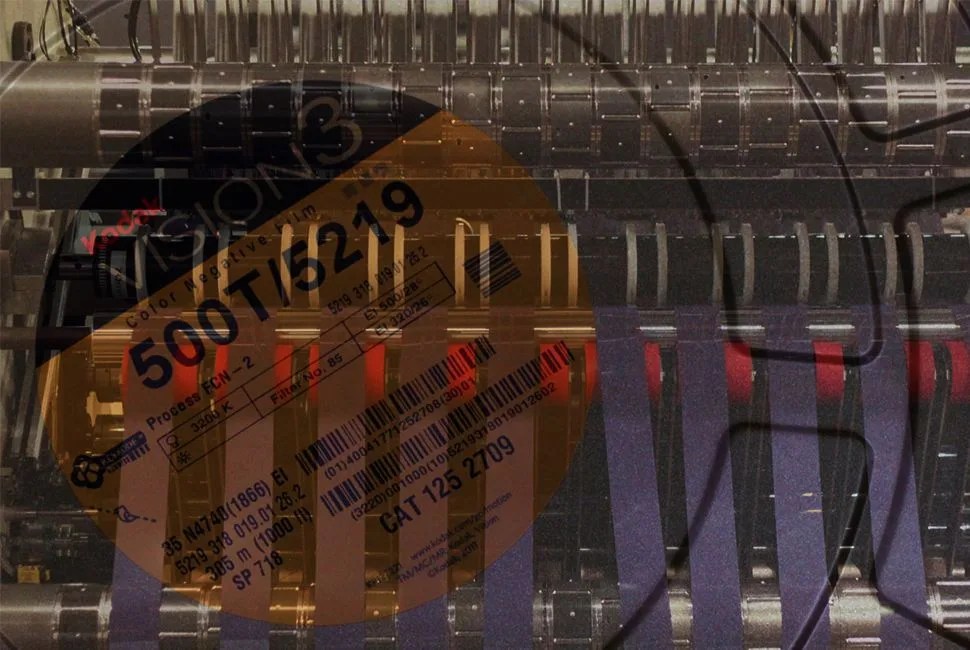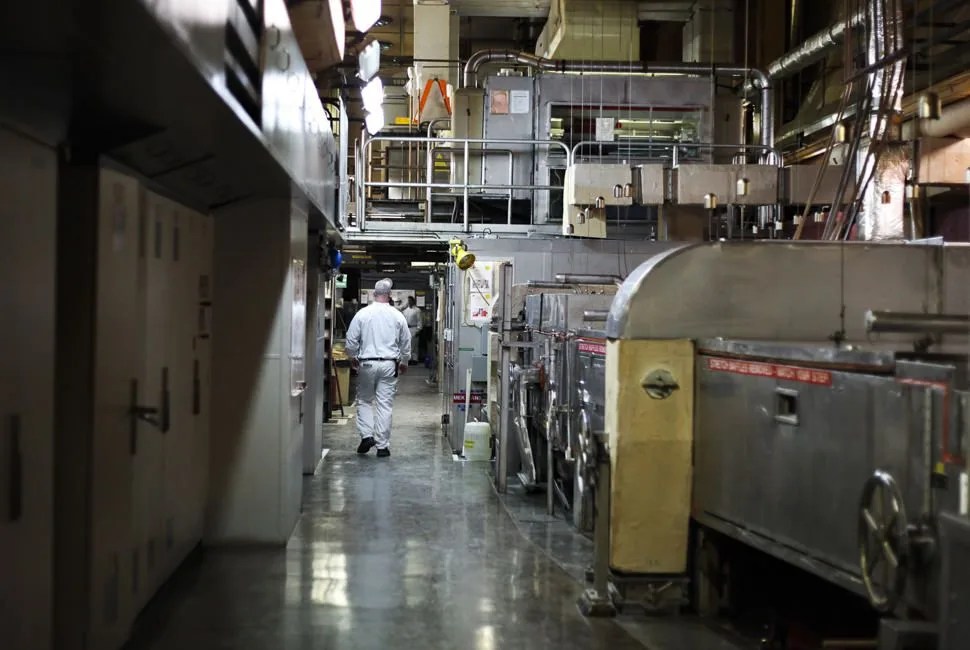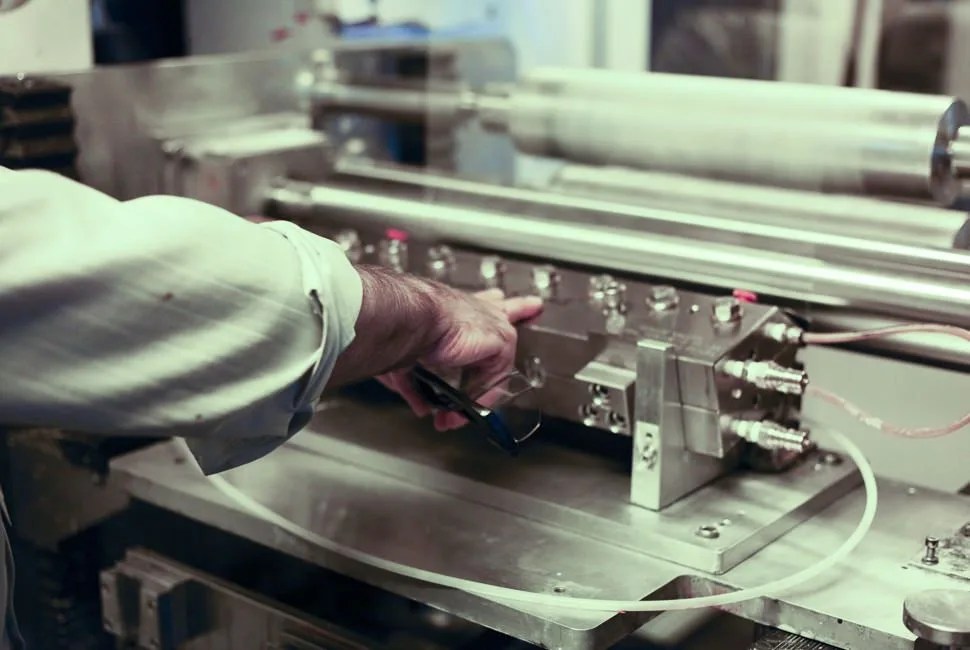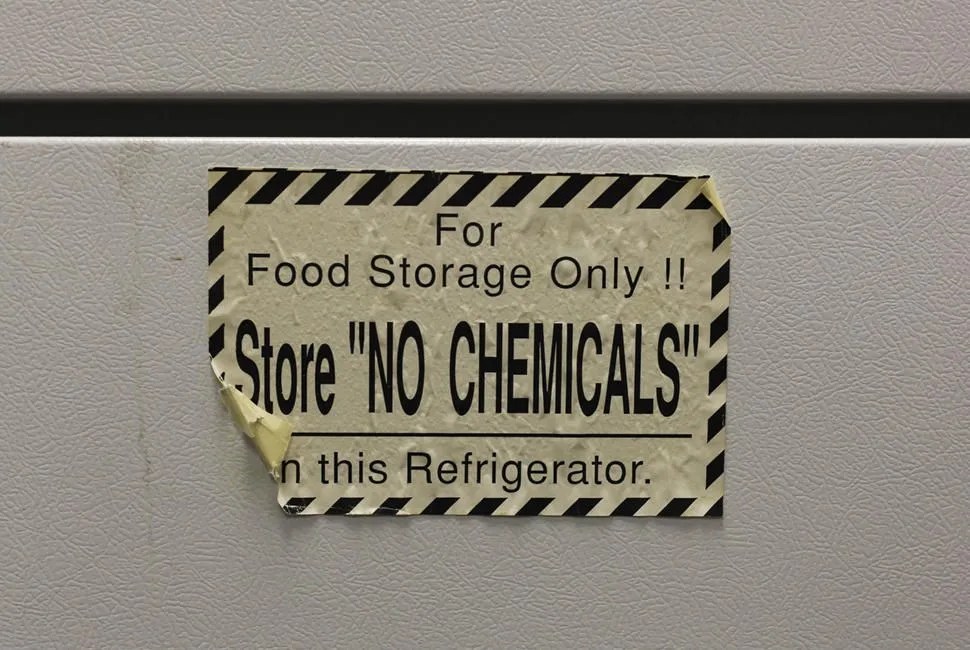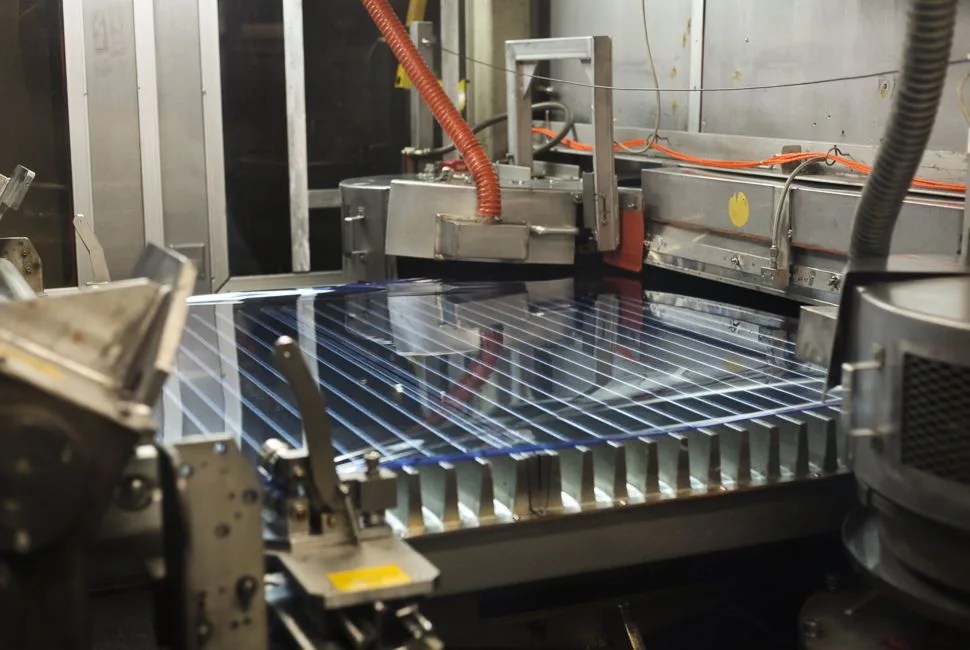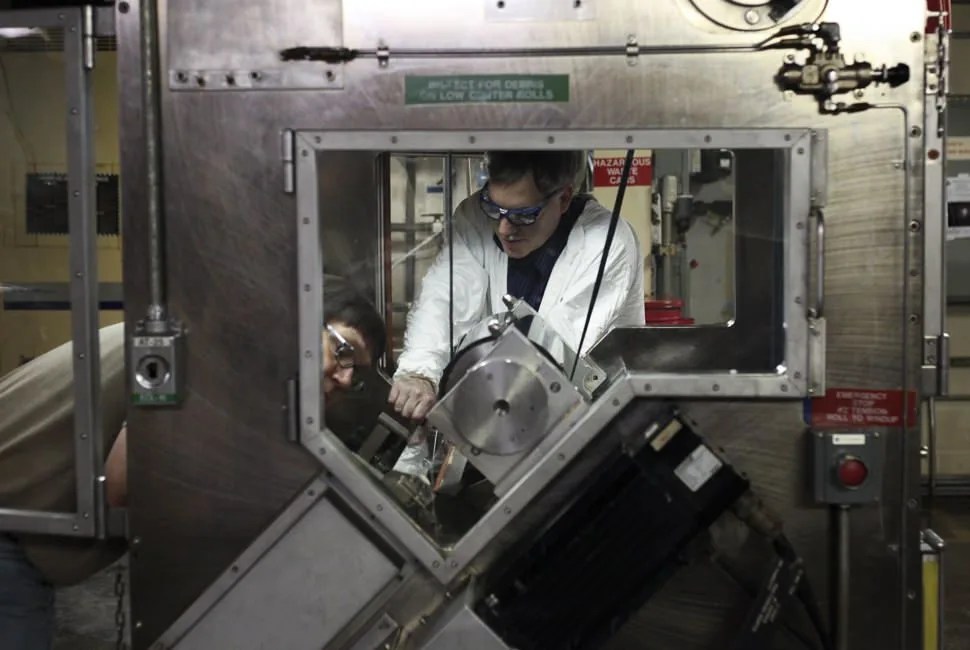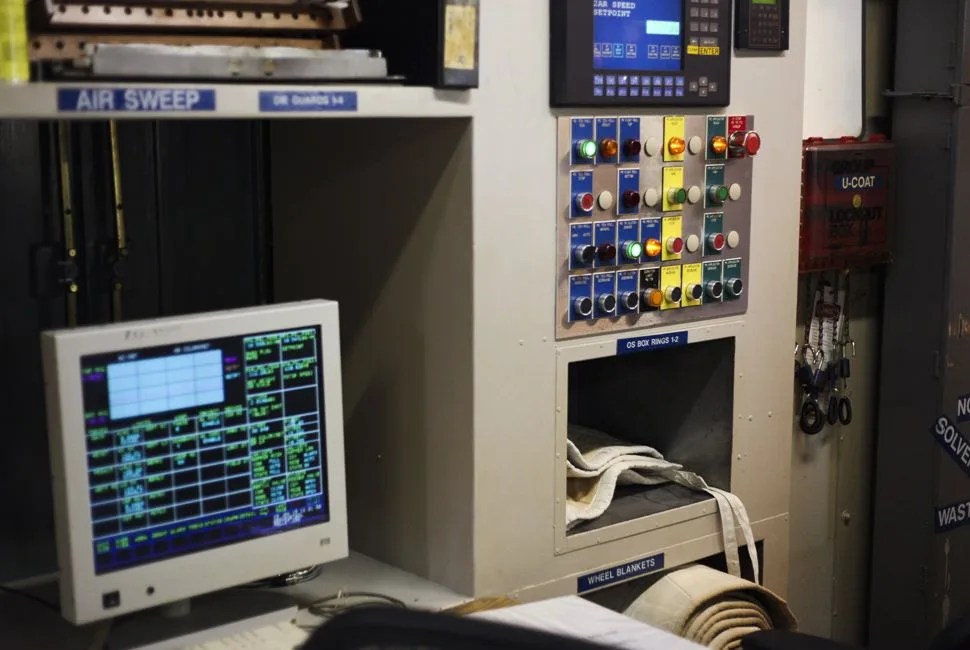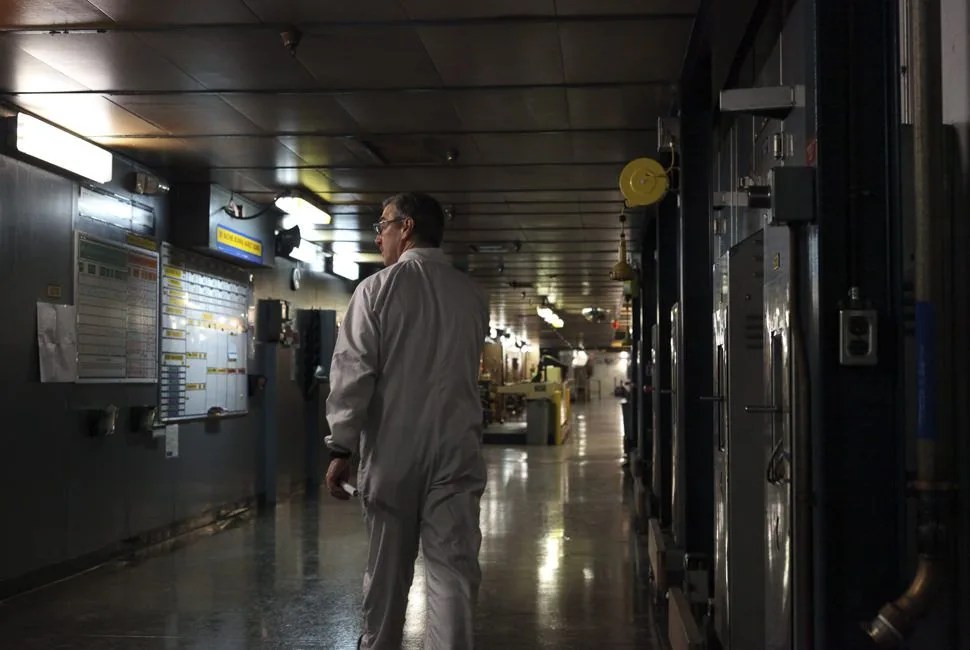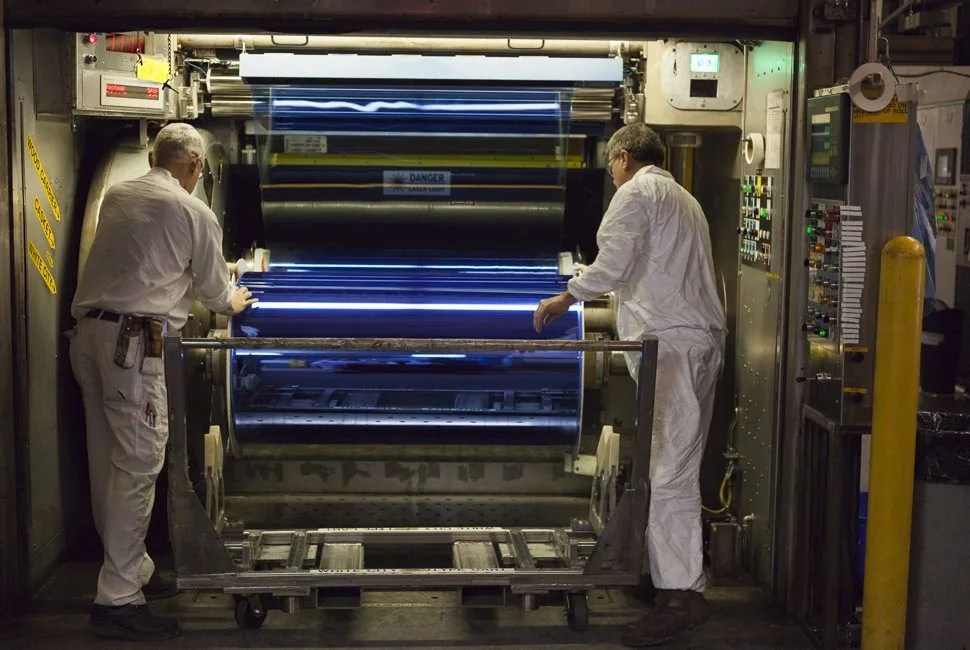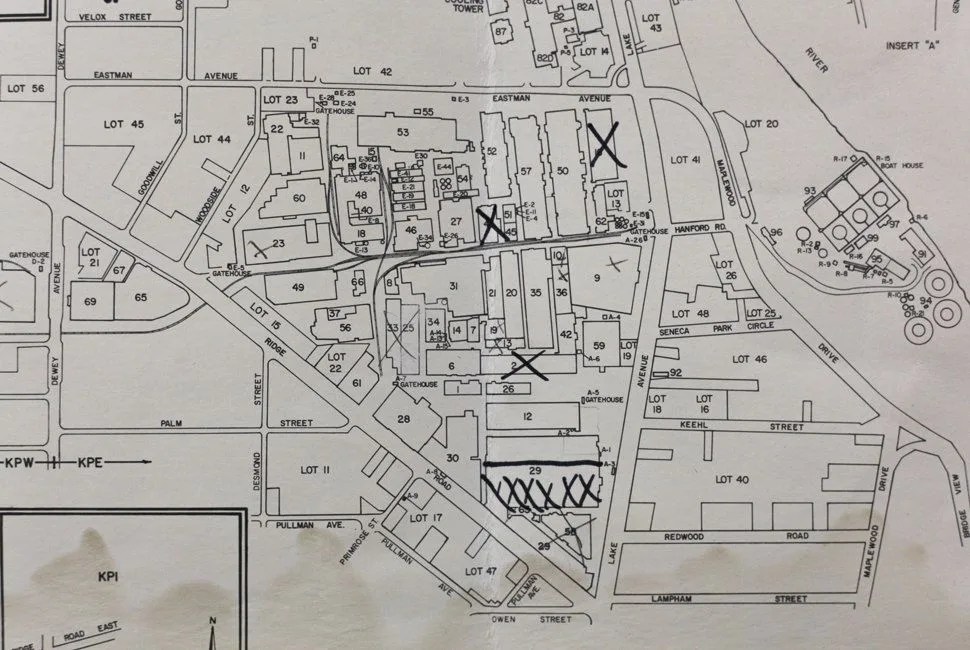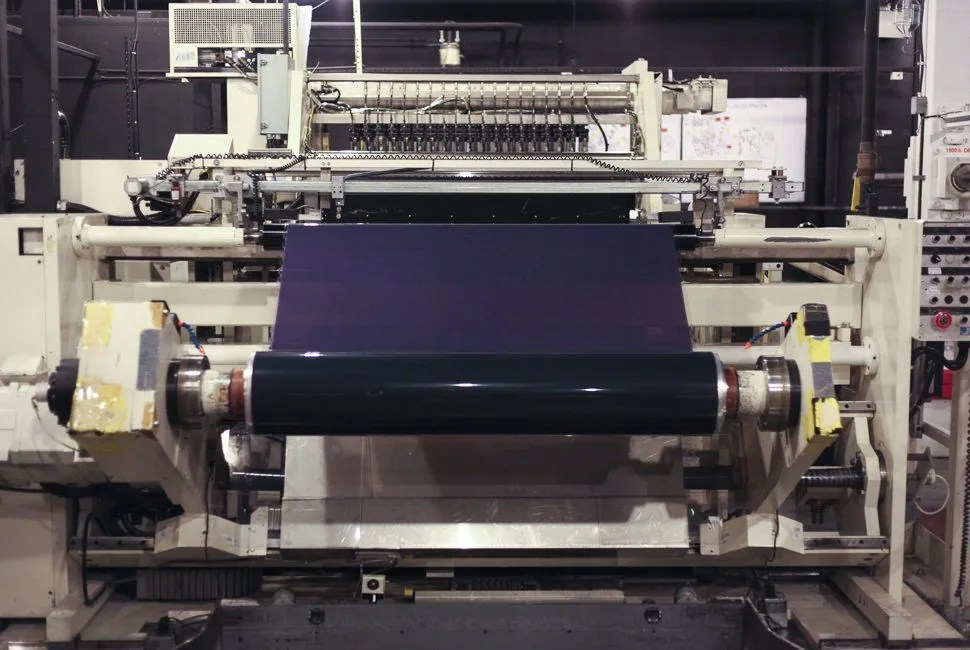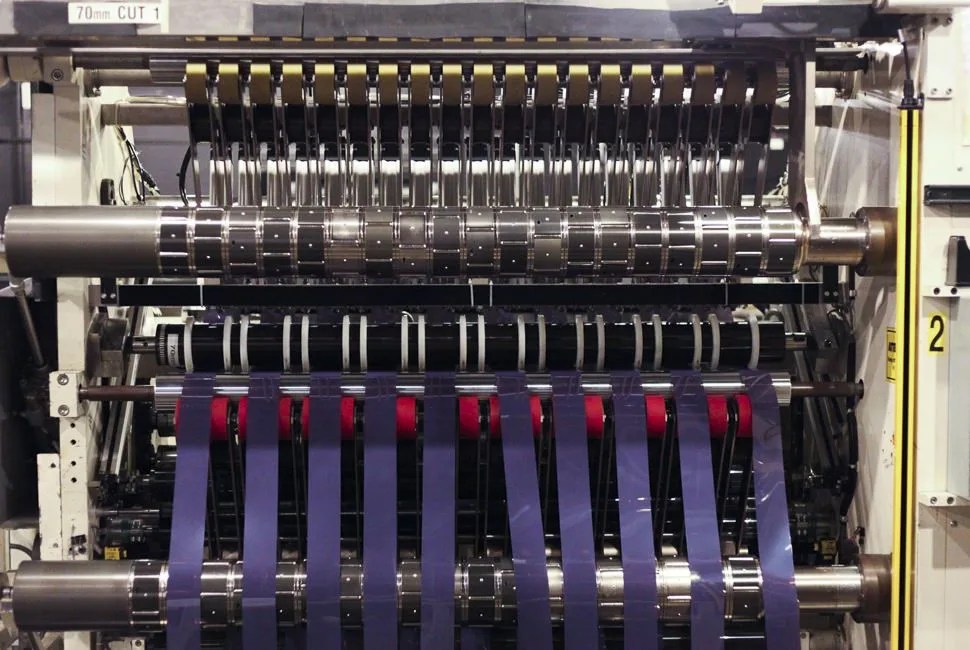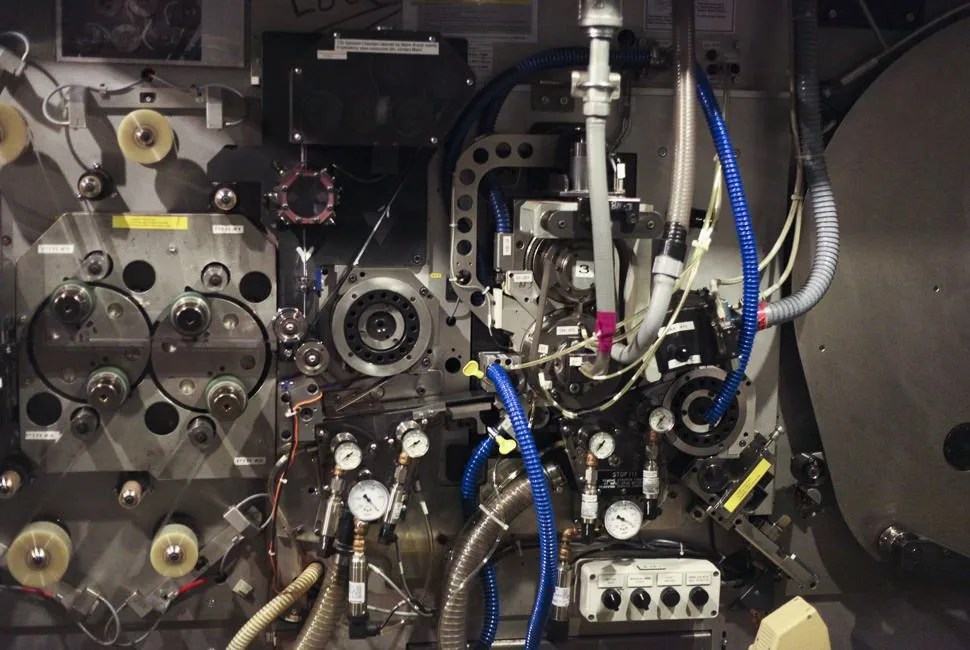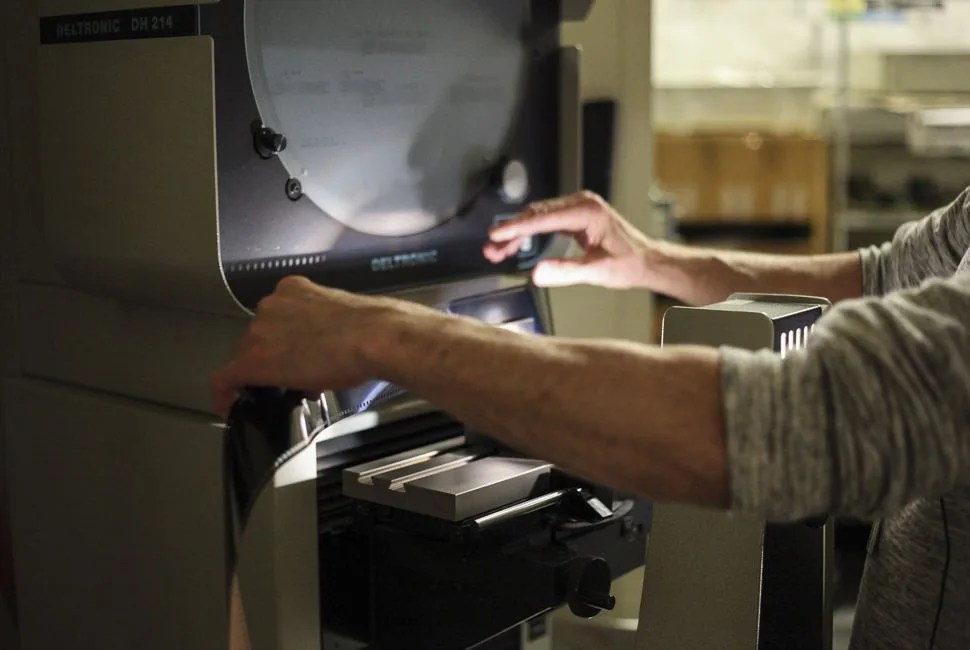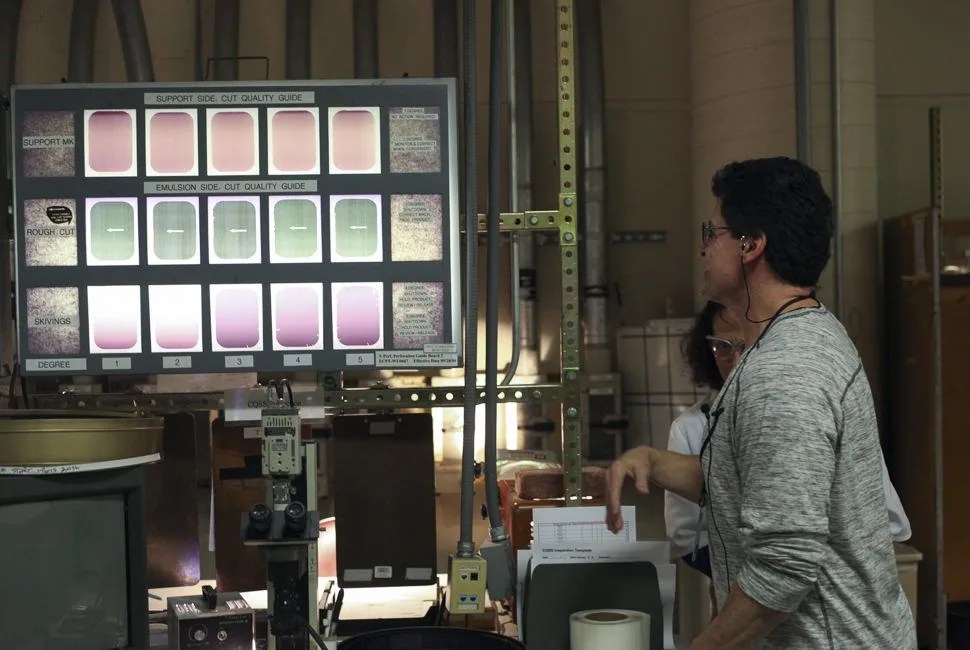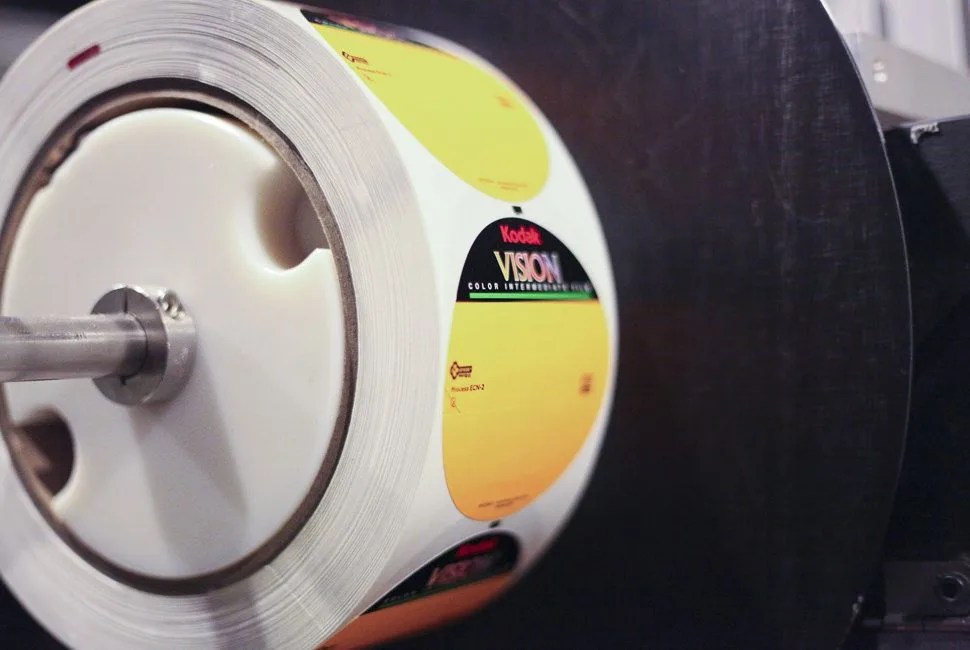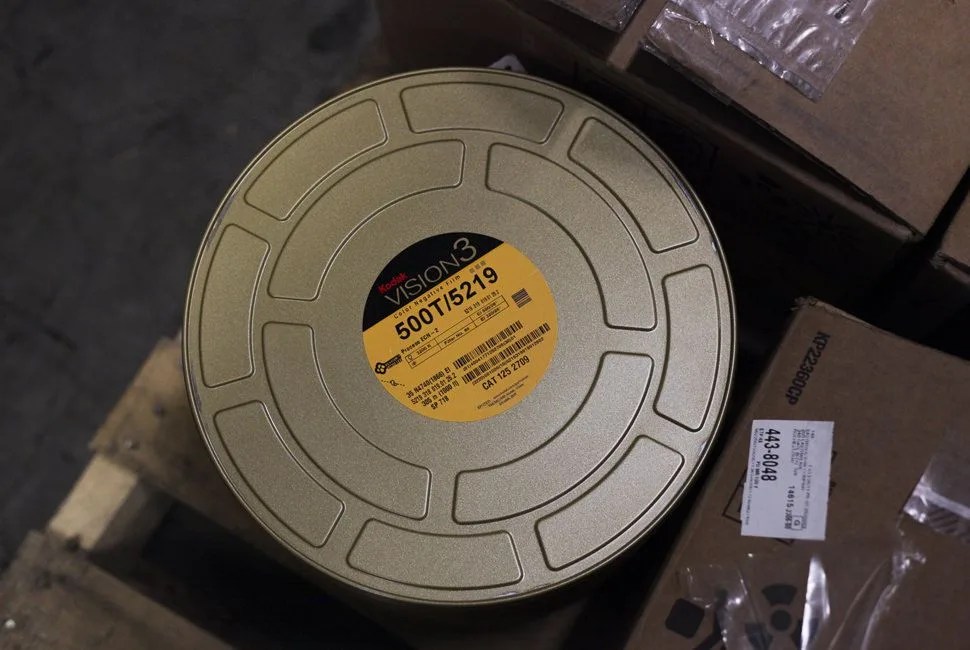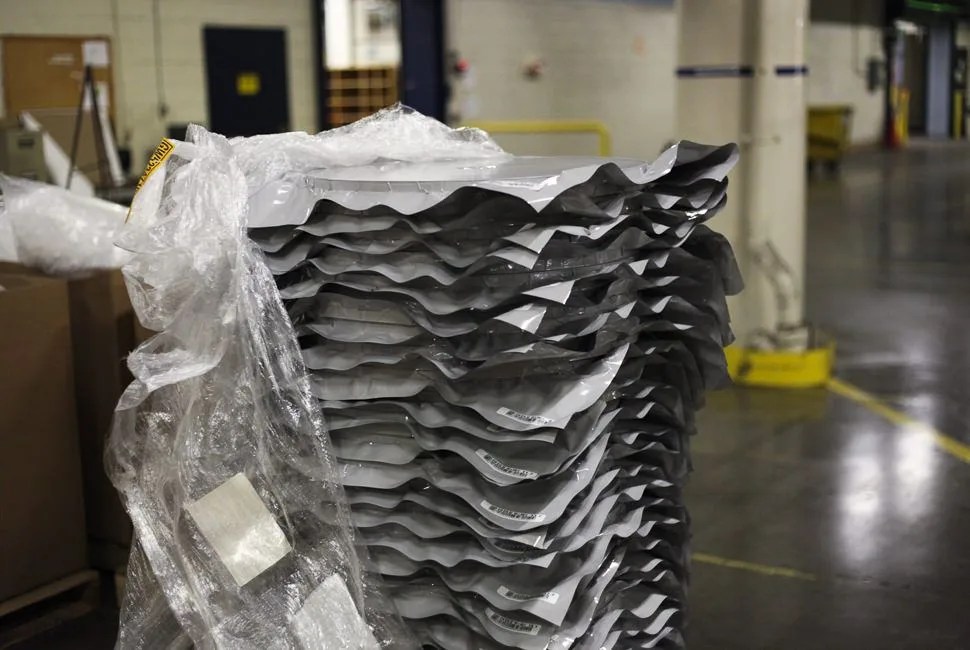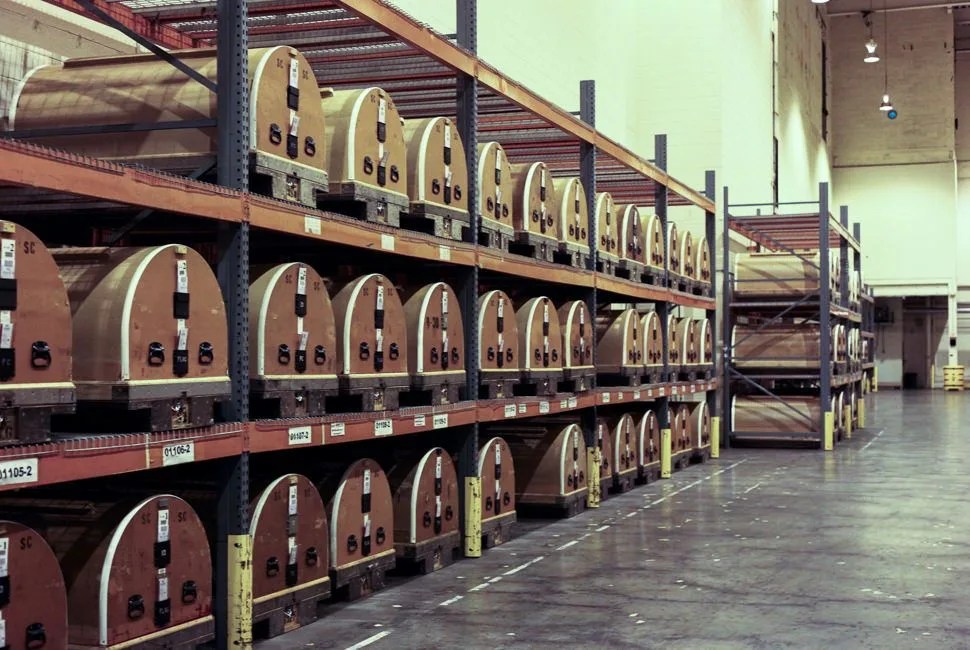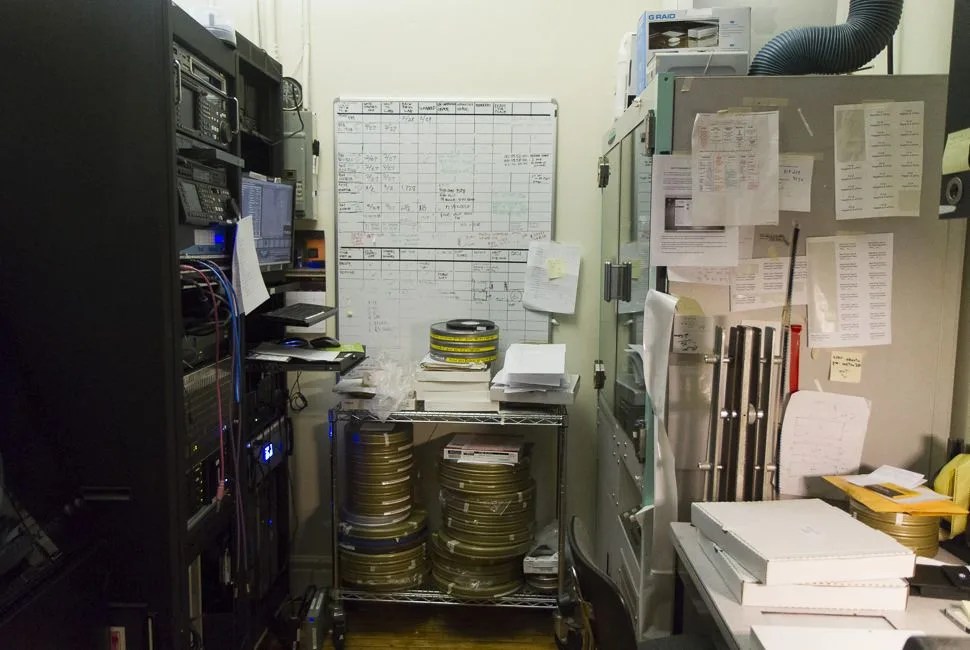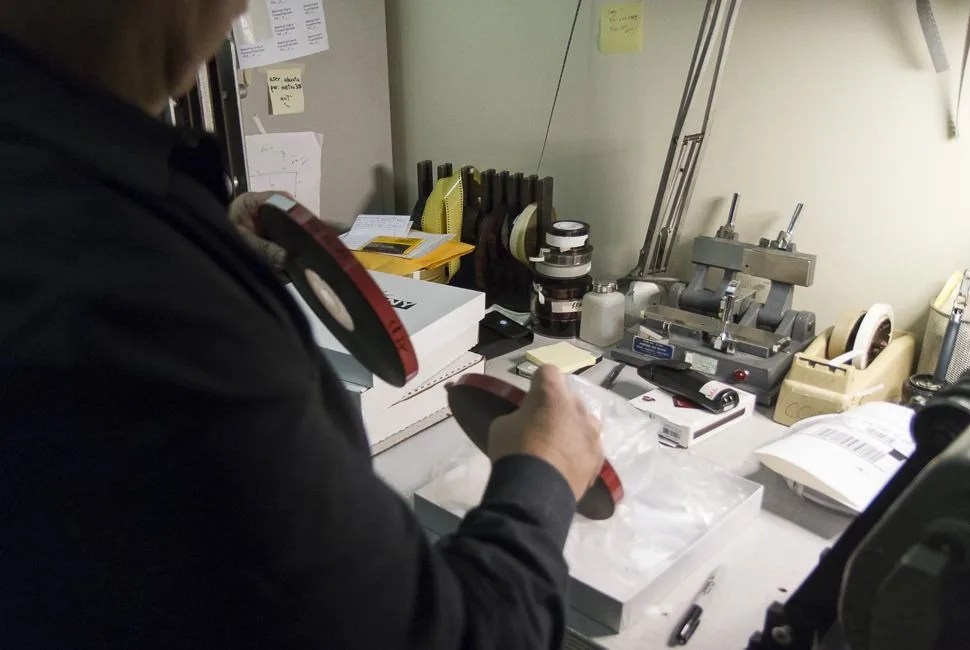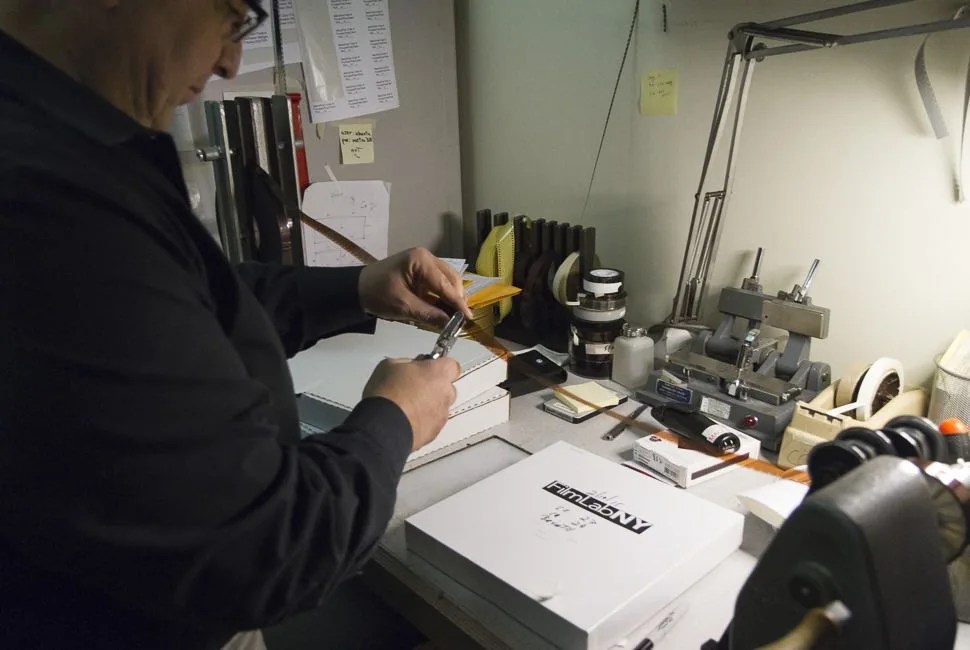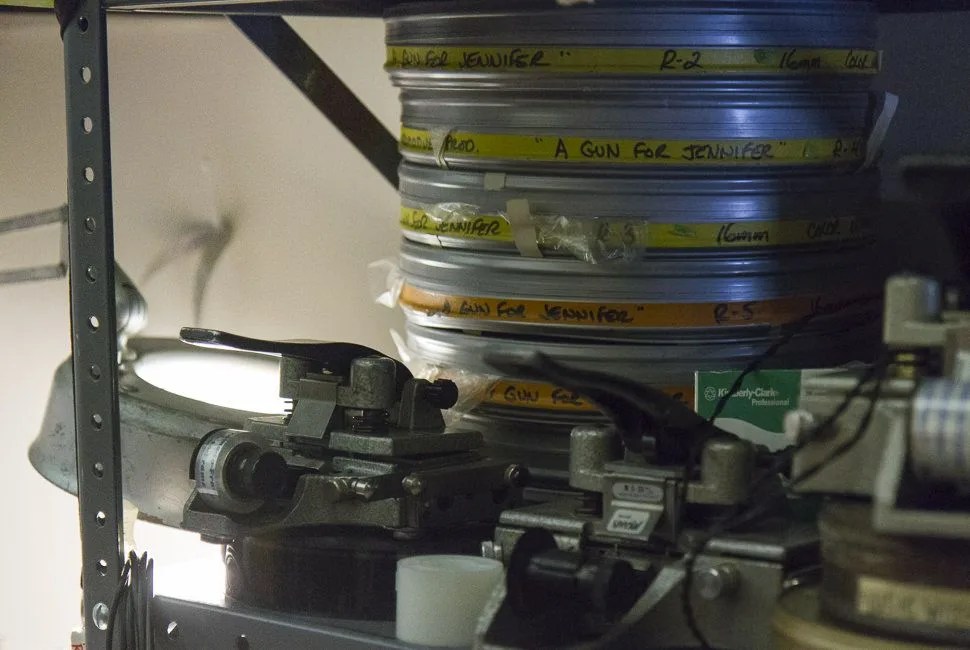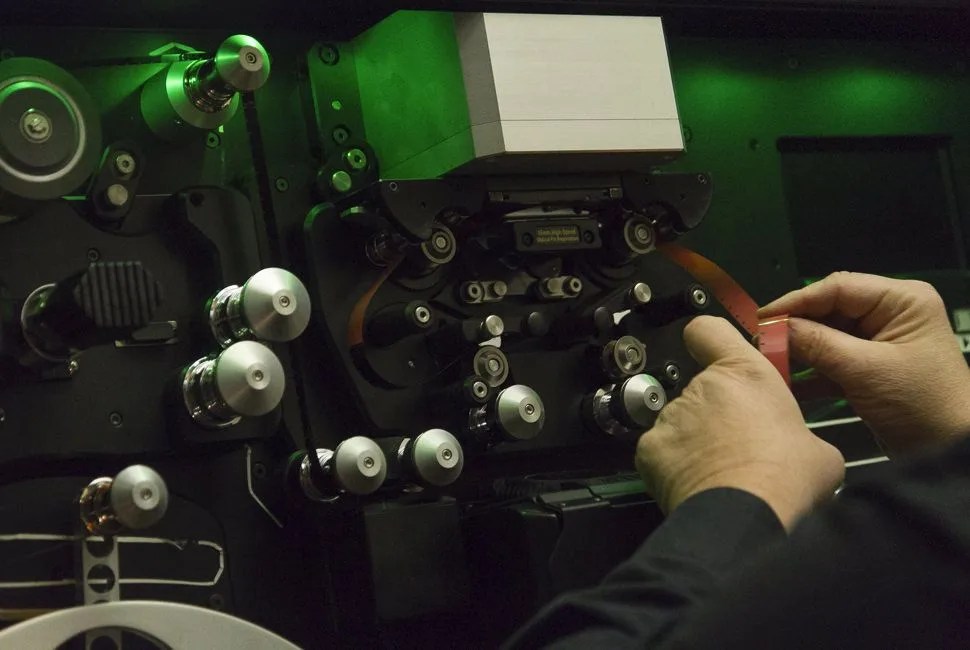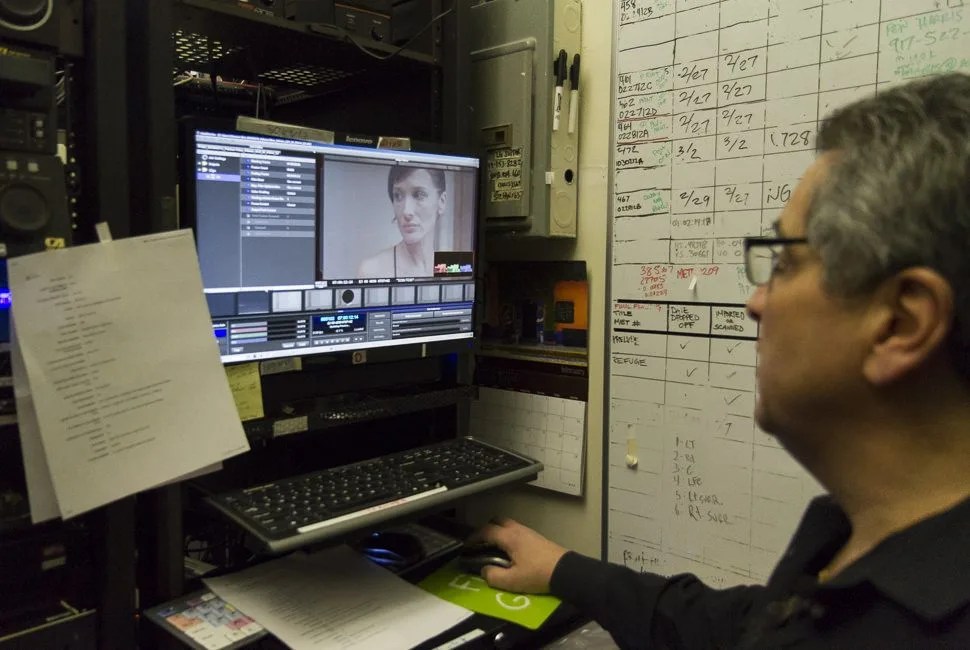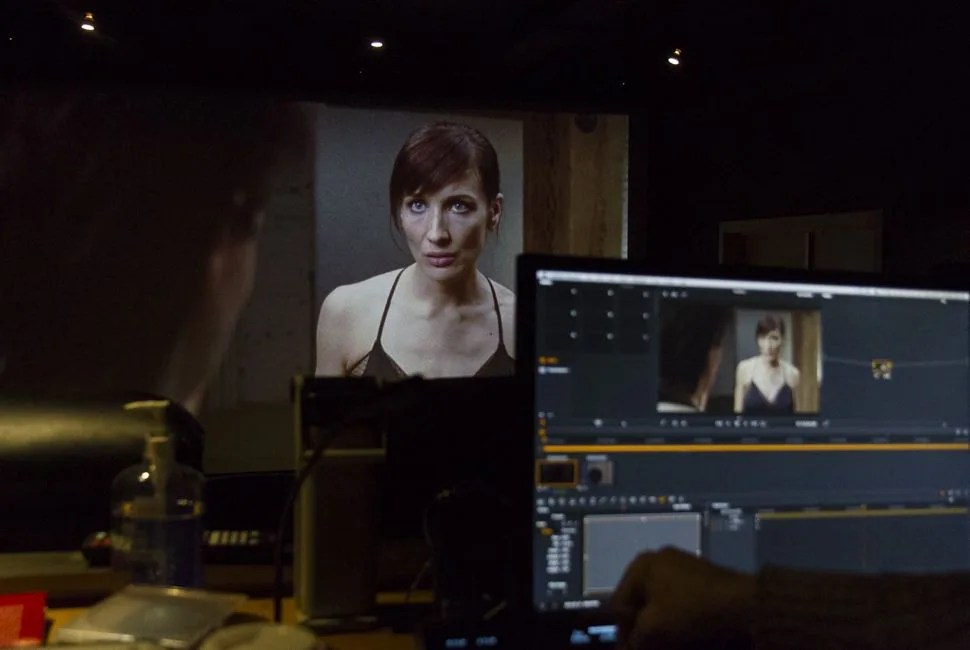As we toured the finishing department, Nancy DiBella, Rochester Film Finishing Operations Manager for Kodak, pointed out the role of each machine and person we passed. She wore a white lab coat and protective glasses, speaking with a quiet modesty that the other workers shared. I asked DiBella if she gets the chance to see movies shot on the film that goes through her hands. “If I know it’s on print, I’ll go see the movie,” she said. “Even if it’s bad.”
The Eastman Kodak factory in Rochester, New York was the first visit in my month-long journey. I wanted to document how Kodak film, which starts as an acetate or polyester base and chemicals, reaches the movie theater screen in a digital era. That process today is quite different from 50 years ago when technicians developed camera negatives by hand and editors cut film with scissors. It’s one that blends the physical and the digital mediums. I interviewed Kodak factory workers, filmmakers, negative processing technicians and colorists, toured labs and offices, all the while witnessing firsthand film’s entire course. Even though the process does integrate digital technology today, I found there’s something special about shooting a movie on film, and part of my journey was to discover why that is.
George Eastman didn’t invent photography. He figured out a way, just like Ford did, to make a product efficiently for the masses.
Kodak is the only company producing motion picture film today, and it seemed appropriate to start in Rochester. George Eastman, the company’s founder and chief innovator, helped define the city by providing countless jobs and contributing to local universities. In 1889, Eastman perfected the first commercial transparent roll film, which allowed for Thomas Edison’s motion picture camera two years later. George Eastman didn’t invent photography; he figured out a way, just like Ford did, to make a product efficiently for the masses. Over the following century, Kodak continued to develop its film and imaging technology, becoming a global powerhouse in the process. Amateur photographers and Hollywood studios alike used Kodak film for decades to document their world and create new ones.
Kelly Mandarano, communications director for Kodak, drove me through Kodak’s 11,000-acre industrial campus. The giant headquarters houses a power plant, water-processing facility, train tracks, its own fire department and brick buildings numbering in the hundreds. Multiple generations have worked in the same buildings and drove along the same roads for over a century. “This is my sixteenth year at Kodak, which seems like a lot, but most people have been here for thirty or forty years so they still consider me a newbie,” she said.
In the mid-20th century, Kodak employed over 30,000 people on its Rochester campus. Employees organized softball leagues, photography clubs and put on plays at the theater. Today the number is closer to 6,000, most of which work for other companies on site renting the buildings. During the late 1990s and 2000s, digital technology in cameras, software and projectors reached a quality and cost that rivaled film and its accompanying technologies.
Photographers’ and filmmakers’ switch to digital hurt Kodak’s still and motion film division, one of its stalwart departments. For example, Kodak manufactured 11.4 billion linear feet of print film for movies in 2007, compared to about 417 million linear feet in 2014. Although their demand will never again reach those 11-digit numbers, Kodak will continue to produce motion picture film, unlike Fujifilm, which bowed out last year. Last month, Andrew Evenski, President of Motion Picture and Commercial Films at Kodak, helped finalize new film supply agreements with all six major Hollywood studios. When asked about the length of the deals, Evenski couldn’t specify, but pointed out Kodak will make film for the artists who want it for many years to come.
Making the Motion Picture Film

I slipped on a full-body jumpsuit that looked like the ones hospitals give to single-day patients. I zipped it up my chest and pulled my sneakers through with two quick tugs. I added plastic glasses that reminded me of high school wood shop. Rick Platner and Debby Smith, two operations managers, wore similar outfits for safety and cleanliness on the factory floor. I followed them through the expansive factory. Long fluorescent lights hung above huge, monochromatic machines. Buttons and switches on the machines and signs on the wall provided the rare bits of color. Hundreds of buildings like this one were scattered across the grounds, each with their own machines and technicians to operate them.
The process for making Kodak’s different films is split into three stages and among three buildings: base manufacture, sensitizing and finishing. The factory Platner and Smith guided me through houses the polyester base manufacturing department. Polyester is the base used for archive films, while acetate is used in their color negative film designed for motion film cameras and print films for projectors. (They import the acetate base, but the polyester process on location is similar.) Acetate, which is more like a transparent glass than a plastic, starts out as a “dope,” or clear goo. When the acetate is in that hot liquid form, it is extruded through small openings onto a huge, polished wheel. As the wheel slowly rotates, the acetate is cooled and dried precisely by time and temperature. The cooler and more solidified acetate is peeled off the wheel like a spatula slipping under a pancake. It’s then dried more and rolled out thousands of feet long to the proper thickness of a few microns, or a few thousandths of a millimeter. Before going to the next building, an anti-static layer is added so the film does not cling to itself, along with a backing layer for a sturdier base.
18 original photos
The second stage is sensitizing, where light-sensitive emulsions are added to the base in complete darkness. A photographic emulsion is a suspension of silver halide particles in a gelatin; colored dyes are added to color negative film. “[Sensitizing] takes our base and they lay down cyan, magenta and yellow, multiple layers of film that then are sensitized to different wavelengths of light,” Smith said. “So it’s lots of layers of different chemical solutions that have specific functionality to reproduce an image.” In short, the different layers are designed to work together and react to light when run through the camera later. There can be 15 to 20 layers in a color film negative on a huge roll that’s microns thick and 12,000 feet long.
At finishing, that film roll is cut to the width and length needed and then packaged for shipping in a film canister, or can. Again in the dark, workers load it onto a shining steel slitter to cut the correct width — 8mm, 16mm, 35mm, 65mm, or 70mm. Then, another machine perforates and cuts the rolls to the appropriate length. For instance, a grad student filmmaker might want a roll 50 or 100 feet long while a Hollywood production will call for a roll 1,000 feet long. Quentin Tarantino wanted an even longer roll for The Hateful Eight, according to Wayne Martin, General Manager of Commercial Film for Kodak. “He wanted to shoot 2,000s, but the camera couldn’t handle it so we made him 1,800s,” she said. “He doesn’t want to take time to switch film camera to camera so he wants long rolls.”
Just as Kodak cut longer rolls for Tarantino, they’ll modify other parts of their normal process when a special project calls for it. For the upcoming documentary Everest: Conquering Thin Air, the filmmakers needed a stronger base for the shooting conditions on the mountain. Martin suggested polyester, usually reserved for archival film because of its toughness and higher propensity to cause a camera jam. “When they were shooting in Everest, they wanted something that was going to hold up to the elements so we made them polyester film with our emulsion set from our 500 tungsten camera negative film,” Martin said.
Before shipping out any roll, technicians check the quality of a part of raw film from each slitter. In the testing department, a magnet board displayed machines in need of repair and others that were out of commission. “Wrapped Around Your Finger” by The Police played on a stereo in the corner. What look liked 1990s-era computers, film strips and comparison charts filled the long white room. Nick, a testing technician, slid a 35mm strip below a microscope hooked up to a boxy television to look for scratches. He turned 180 degrees to another machine and slid the same strip into the slot. “We’ll put it through what we call an optical comparitor, and this tells us if the product’s shaking up and down or not,” he said. “You don’t want it shaking when it’s going through a movie film camera.” If it does shake, the movie will appear jittery and you will see frames’ borders. After he approves the film, it can be shipped off to the filmmakers.
Shooting the Movie

Photo by Shawn Bannon
Director Alex Ross Perry and his director of photography Sean Williams joined us at our Manhattan office to talk about why they choose film and explain their shooting process. Together, they have shot one independent movie on Fujifilm film and three on on Kodak, including Listen Up Phillip and Queen of Earth, which recently premiered at the Berlin International Film Festival. Perry wore a button-down under a sweater and spoke with an eloquence that matched the dialogue in his films. To his right, sporting a navy baseball jacket and shaggy beard, Williams joked about his reverence for corded and mechanical objects.
While they work on smaller productions, the procedure on bigger budget films is similar, scaled up with longer film rolls and more assistants helping out the cameraman. The morning before a shoot, Perry and Williams will discuss what they’re looking for that day. Perry mentions a few scenes from films as inspiration and trusts Williams to take it from there. Williams or the first camera assistant will load the unexposed camera negative roll from its can into a camera magazine, a light-tight chamber or pair of chambers designed to hold the film that hooks onto the camera. A magazine is composed of a “pay-out” side, from which the camera loads the film, and a “take-up,” where the film is held after the being exposed. If they reach the end of a roll during shooting, they’ll replace the magazine with an unexposed one. During a shoot, Perry can focus on directing the actors’ performances while Williams operates the film camera from his shoulder. Through the viewfinder, Williams adjusts exposure and racks focus if needed, often walking between and around the actors like one of the characters. Instead of checking and double-checking a digital monitor for each shot, Perry and Williams trust themselves and the film to produce the results they want.
After each day of shooting, film crews send the film cans out to a processing lab. On his first two films, Perry instead waited until the end of the shoot to process all of his film cans. “The rolls piled up because we just dropped them all off at the end,” he said. “That’s a real reckless way to feel. Like you might get home, develop this and find out three weeks after everybody left that none of it worked — and there’s something kind of thrilling about that.”
Processing the Negative

Kodak is only one link in the chain of companies that makes shooting on film possible. In 2015, filmmakers like Perry still need the camera and its lenses to shoot on set and a processing lab to develop the camera negative before it gets converted to digital. David Feldman, Director of Feature Sales at Company 3 NY and Deluxe NY, invited me to see the disassembly of Film Lab NY’s processing lab located in the basement of the Deluxe facility. Workers cut metal pipes that pumped processing fluids only a few months ago, in December 2014. The darkroom where they opened up film cans for decades was stripped and machines once flowing with chemicals were empty. “It’s hard to believe that three months ago you could eat off the floor here. That’s how clean it needed to be,” one worker said.
Kodak’s agreed to make the film, the studios agreed to buy it, but what about processing?
After touring the basement, I walked up to the modern Deluxe office. Formerly a film processing facility, they switched their main focus to digital post-production with the rest of the entertainment industry years ago. He spoke pragmatically about the digital transformation and predicted film may only survive for a few more years. “Kodak’s agreed to make the film, the studios agreed to buy it, but what about processing?” Feldman said. “Film stocks without a lab for developing are paperweights.”
Without processing labs, a filmmaker’s camera negatives are useless. Specific numbers are hard to come by, but there’s only a handful of processing labs in the world left today. Industry experts pointed to Foto-Kem in Los Angeles as the last major processing lab after Film Lab NY closed its doors. A smaller lab in Maryland called Video & Film Solutions has survived because of its proximity to the Library of Congress and National Film Archives, which require regular processing for duplicating and preserving their vast collections.
Video & Film Solutions owner Ernie Aschenbach explained the processing of a film roll negative. Aschenbach receives the film can from a director like Perry. First, his employees open it in a dark room and feel along the edges checking for torn perforations from camera malfunction. Then, the roll is loaded into the processing machine, which is half in the dark and half in the light. It goes through a pre-bath to remove the carbon backing, Aschenbach explained. Then, it’s developed, stopped by sulfuric acid, washed and exposed to light. “When it comes into the light, it goes through a bleach, wash, fix, wash, stabilizer, then it goes through a drying cabinet, and finally it’s taken off at the other end,” Aschenbach said. The chemical development process at their lab takes only 25 minutes to get the first foot off.
Getting processed film back the next morning is a thing of the past unless you shoot within an hour of a processing lab. Filmmakers today understand the situation and still value the processed result over digital despite a longer turnaround. Kodak hopes the remaining labs will keep their doors open, but there’s only so much they can do. Their agreements with the Hollywood studios will sustain the remaining labs, but owners like Aschenbach are the ones still dealing with decreased demand for their processing machines.
Digital Post-Production

In a small office on 30th Street in Manhattan, Jack Rizzo, president and partner of Metropolis Post, opened up a can of developed negative, like one that Perry had shot on, to digitally scan on a sleek black scanner and its accompanying computer. Rizzo spoke like a no-nonsense uncle, getting to the point while telling great stories. On the opposite wall, old film canisters such as Bob Dylan’s 1967 Don’t Look Back documentary lay on shelves. That room symbolizes the moment when the physical meets the digital. Rizzo takes a heavy film roll that went through Kodak’s factory and the film camera and turns it into data.
Rizzo first makes a hole punch on what’s called “A-Frame” to start the timecode for an editor. He then loads the roll onto the scanner and sets the specifications for the output raw video file. At 12 frames per second, the scanner shoots red, green and blue light at each frame to create the digital image. It utilizes a version of Kodak’s Cineon file to translate the physical densities of a negative into code values in the digital file.
8 original photos
Within a couple hours, Jason Crump, Rizzo’s partner and the company colorist, takes the video file and goes through an initial color correction. Before digital coloring software, a color timer would rotate knobs controlling red, green, blue and density to produce the desired colors and brightness on the print. In this swift first check, Crump uses a print emulation look-up table as a reference that reproduces color and contrast results as though the camera negative were printed on print stock for screening. “Color negative film is inherently low contrast and it’s designed to be that way,” he said. “The reason is the film wants to capture the most dynamic range that’s available in any given situation. Contrast came when you printed it. Now, contrast comes when you dial it in digitally on correction software.” More nuanced corrections are done when the film is edited and he can sit down with the director and director of photography. For now, he sends the colored file to the editor that day so the filmmakers can look at what they have and work more from there.
Instead of editing with a blade and film cement (which Kodak still sells) like Gerry Hambling on Midnight Express, editors today use programs like Final Cut or Adobe Premiere. While physical editing was sometimes heralded for the surprise results it yielded, digital editing, like color correction, was a welcome improvement in Hollywood. Editors have access to more video and audio tracks and splices are no longer permanent.
After the editor completes his cut, Crump schedules meetings with the filmmakers to refine each shot of the film. A colorist and director of photography might work for hours on a single scene given the options in digital color correction. Most filmmakers opt for a realistic style instead of something specific like Minority Report so they don’t spend forever tweaking a shot. “You can go crazy, but in the end, the goal is to represent the story in the best way possible,” Crump said. “The things that we’re doing in here are really just maintaining a look that has already been created on set and it’s just a matter of supporting that look.” Minimal post-production work, especially on a 16mm stock, highlights the texture and saturated colors that filmmakers choose Kodak film for in the first place.
Screening the Movie

If a filmmaker shoots on 16mm or 35mm film, they will likely want to project on the same medium, but that’s no longer the popular choice. In most cases, the colorist will export digitally onto to Digital Cinema Package (DCP) to ship to movie theaters around the world. Most movie theaters converted to digital projection around the 2009 release of Avatar, while only art houses and museums retained their film projectors. At the 2014 Cannes Film Festival, Quentin Tarantino said, “It’s not even about shooting your film on film or shooting your film on digital. The fact that most films now are not presented in 35mm means that the war is lost. Digital projection, that’s just television in public. And apparently the whole world is OK with television in public, but what I knew as cinema is dead.”
In some cases, filmmakers still do put out movies on film, but it is now mainly for a foreign market or special screening. In November, Nolan pre-released Interstellar, some sections of which were shot on Kodak 65mm, to project on 70mm in theaters before its digital wide release. Independent filmmakers have less financial power and must work within mainstream parameters. Perry only made a print of his first film in 2009; since then, he has shown his subsequent three films exclusively digitally. He’ll export a DCP for movie theaters, ProRes Quicktime file for the festival circuit or Blu-ray for a home theater.
Like vinyl, film projection may make a comeback. Kodak recently announced its “Filmworthy” marketing campaign to push filmmakers to shoot their projects on film. Tarantino’s 70mm roadshow presentation of The Hateful Eight last year was a good indication, as was Nolan’s treatment of Interstellar. Art house, museum and university theaters regularly premiere new and old 35mm prints. The nonprofit Cinema Conservancy releases and preserves works of American independent film, focusing on projects of historical and social significance that, for one reason or another, have gone under-seen. Executive Director Jake Perlin seeks out movies that pique his interest and helps to strike new 35mm prints from the negative. He then releases the work on a national tour to introduce it to a new generation of audiences. “I think that people get used to seeing things digitally, and I certainly have, too,” he said. “But then you see a beautiful 35mm print, and it’s a whole other experience.”
Past the initial screenings, filmmakers may also preserve their completed projects on film. Film is proven to last at least a hundred years in optimal conditions. Katie Trainor, MoMA Film Collection Manager, spoke about their film preservation center in Hamlin, Pennsylvania. The museum’s state-of-the-art preservation center houses inspection areas, viewing flatbeds, 24 safety vaults and 34 nitrate vaults. “Those are all kept at forty-five degrees Fahrenheit and thirty-five percent humidity,” Trainor said. By comparison, new digital formats appear every few years and old ones can no longer be read. Imagine trying to play a VHS today, in other words. Even if filmmakers shoot digitally, film is a sure preservation method for future generations.
Why Film?

The argument for digital filmmaking is clear, but what film offers is less tangible than numbers on a spreadsheet. Digital camera manufacturers such as Arri have come close to recreating the look of Kodak’s color negative film stocks. High-end sensors capture a wide dynamic range and color spectrum similar to film’s capabilities. The purpose of shooting film is also questionable when so much of the workflow is digital. The cost, especially on independent projects, is often more affordable. In the 2012 documentary Side by Side, Lena Dunham says, “Without digital video culture, I don’t think I ever would have been making movies because I came at it as a writer.” Why have some filmmakers stuck behind film when the majority switched to digital? What is it about film that some people find special?
For some filmmakers, the “look” is still something worth shooting for even though digital cameras is close in quality. Perry and Williams shot on 16mm color negative film, and their movies contain a grainy, tactile texture and look different from the reality a digital camera might render. “When you go sit there at a screening and you’re not looking at exactly the same thing, something a little bit idealized,” Perry said. “I think that speaks to what I find interesting about filmmaking.” While digital cameras and their pixels render a scene sharp and realistic, film and its random dye clouds smooth out lines and colors. The experts used words like “tactile” and “organic” to describe what stands out to them in film. Those qualities could result from grain, different layers of the film stock, or just the knowledge that this was a physical object.
On set, some directors and actors believe shooting on film produces better performances because they can hear the money running through the camera on set. In Side by Side, director Joel Schumacher says shooting digitally impaired his process. “It’s very destructive sometimes. I’ve worked with a couple of actors who insist on looking at every take.” On the opposite side, Robert Rodriguez says, “I could shoot as much as I wanted [with digital]. I could get the best performances. I didn’t have to worry about shooting these little bursts of film.” Either can yield the better result; it’s more about what people prefer.
While studios often push filmmakers to shoot digitally, the difference in cost may be less than we think. A Canon 7D Mark II is perfect for a $6,000 independent film, but the gap in savings is not as large at the major Hollywood production level. David Feldman shed light on how little that difference is today. “We’re not talking the difference between a movie costing $10 million and $30 million,” he said.” It’s maybe $10 million and $10.4 million, and most of those millions of dollars are spent on above-the-lines cost,” such as directors’ or writers’ salaries. While Kodak’s negative stock and processing fees add up, shooting digitally incurs its own additional costs as well. Letting a digital camera roll while capturing terabytes of 4k data on set leads to longer copying times and more hard drives to back it up on.
Filmmakers like Scorsese and Nolan recognize the benefits of digital filmmaking technology, but plead for the medium that defined the art form of cinema to remain.
Digital cameras and technology like color correction programs and projectors democratized not only filmmaking, but viewership. Anyone with a smartphone can make a video today; they can also stream thousands of movies. Filmmakers like Scorsese and Nolan recognize the benefits of digital filmmaking technology, but they plead for the medium that defined the art form of cinema to remain. In an August 2014 letter, Scorsese wrote, “It seems like we’re always being reminded that film is, after all, a business. But film is also an art form, and young people who are driven to make films should have access to the tools and materials that were the building blocks of that art form.” Film and digital can and should coexist, the argument runs. While digital offers affordability and more post-production options, film contains that unique look and a significance that audiences recognize.
The debate of film versus digital roars every day in Hollywood. Franchises from Star Wars to James Bond are returning to film and Kodak’s deals with the major studios mean film will remain an option for at least a few years. Average moviegoers can decide for themselves if they want to support film, and if this all even matters to them. Certain filmmakers are passionate about the medium of their projects — and that may not even translate to the viewer. When asked in an interview about filmmaking’s shift to digital, cinematographer Roger Deakins responded, “You know, I’m not nostalgic for a technology. I’m nostalgic for the kind of films that used to be made that aren’t being made now.”
